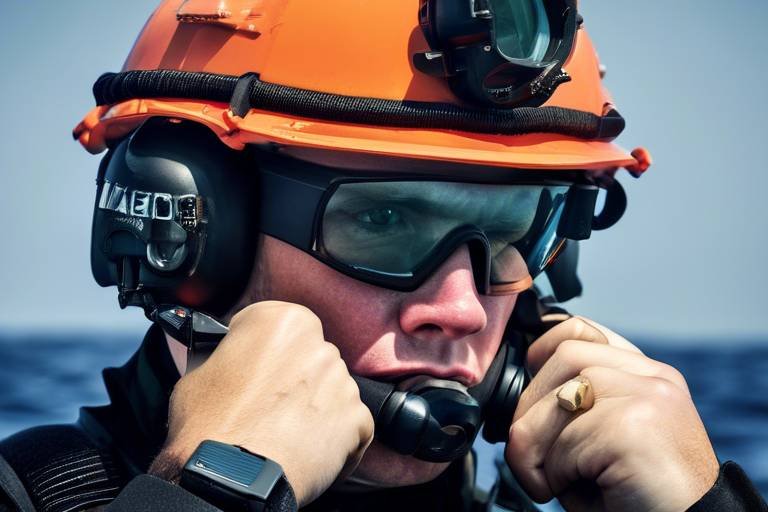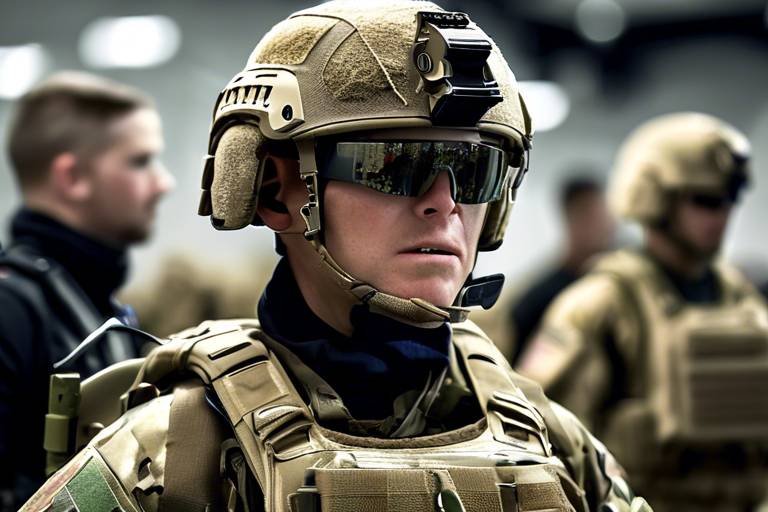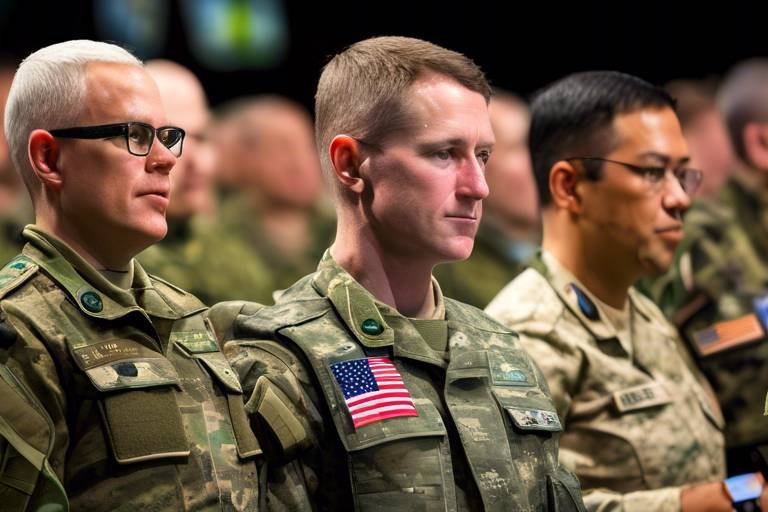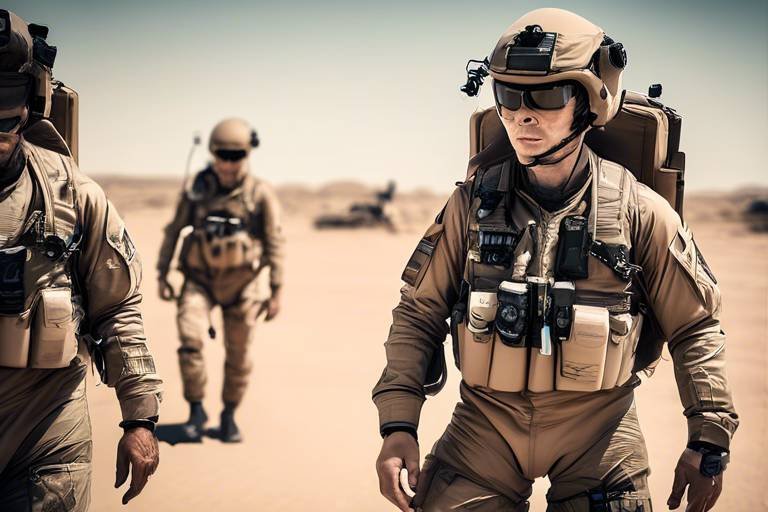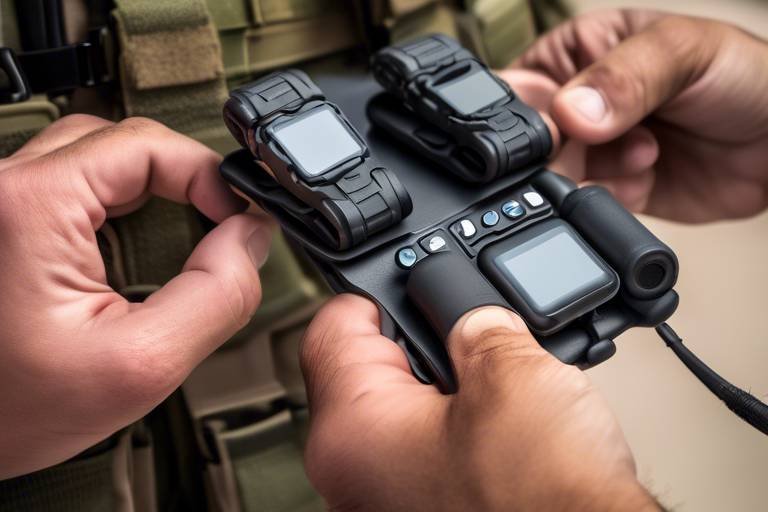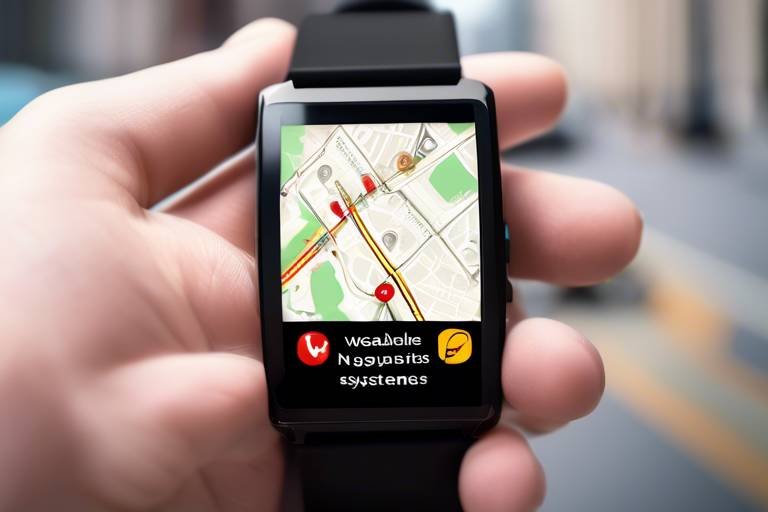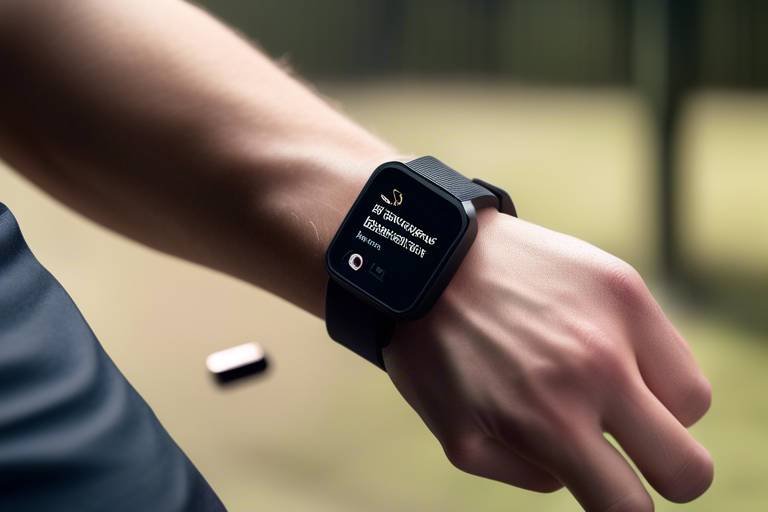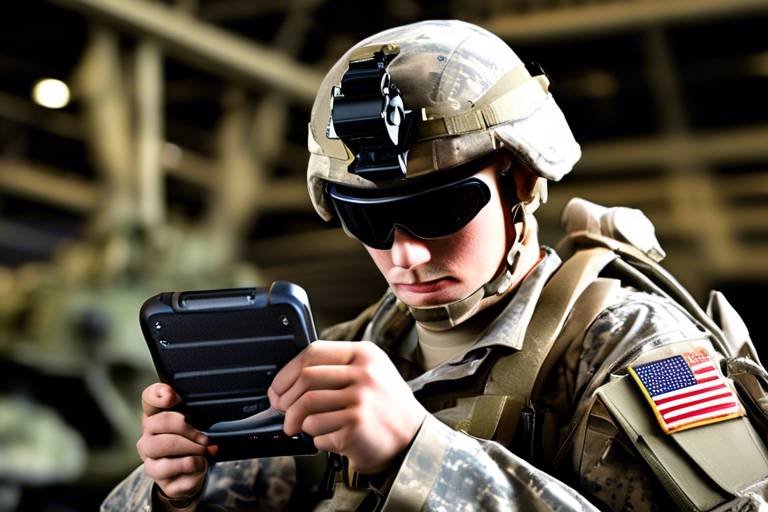The Impact of Wearables on Combat Strategy
In recent years, wearable technology has made a significant leap from the realm of consumer gadgets into the heart of military operations. Imagine a battlefield where soldiers are not just equipped with weapons but are also enhanced with technology that monitors their health, keeps them connected, and provides real-time data to inform their decisions. This transformation is not just a trend; it’s a revolution that is reshaping combat strategies and enhancing the effectiveness of military forces around the world.
Wearable devices, once seen as mere fitness trackers or smartwatches, have evolved into essential military tools. They are now capable of tracking vital signs, providing GPS navigation, and facilitating seamless communication among troops. This evolution has been driven by the need for improved soldier performance and situational awareness in combat scenarios, where every second counts and the stakes are incredibly high. As we delve deeper into this topic, we will explore how these technologies are changing the face of warfare and what challenges lie ahead.
The journey of wearable technology in the military context is fascinating. Initially, wearables were primarily designed for personal use, focusing on health and fitness. However, as the demand for advanced military capabilities grew, so did the innovation in wearable tech. Today, we see devices that not only track movement and health metrics but also integrate with complex military systems to provide critical information at a moment's notice.
From the introduction of basic fitness trackers to sophisticated devices that can monitor a soldier's heart rate, body temperature, and even stress levels, the evolution has been remarkable. These advancements have paved the way for a new era of military operations where technology and human capabilities work hand in hand.
One of the most significant advantages of wearables in combat is their ability to enhance situational awareness. In chaotic environments, soldiers equipped with wearables can access real-time data that helps them make informed decisions quickly. Imagine being in the heat of battle and having instant access to critical information about enemy positions, troop movements, and environmental conditions—all at your fingertips.
Wearables facilitate seamless communication among troops, ensuring that critical information is shared instantly and effectively. This capability is crucial in combat scenarios where traditional communication methods may fail. With wearable devices, soldiers can communicate through voice, text, or even visual data, allowing for a more coordinated and responsive approach to combat.
GPS-enabled wearables play a vital role in improving navigation and positioning. These devices help soldiers maintain their bearings in unfamiliar terrain, which is essential for mission success. By providing accurate location data, wearables ensure that troops can execute their missions more effectively, reducing the risk of getting lost or ambushed.
Health-monitoring wearables are another game-changer. They track vital signs such as heart rate, oxygen levels, and stress indicators, enabling swift medical responses. In high-pressure situations, this data can be lifesaving, allowing medics to assess a soldier's condition quickly and provide necessary care without delay.
The integration of data analytics with wearables allows for better decision-making by analyzing patterns and predicting potential threats. By collecting and analyzing data from various wearables, military leaders can gain insights into troop performance, health metrics, and even enemy movements. This data-driven approach enhances strategic planning and operational effectiveness on the battlefield.
Despite the numerous benefits, implementing wearable technology in combat is not without its challenges. Issues such as reliability, cybersecurity, and user adaptation pose significant hurdles that must be addressed. For instance, what happens if a soldier's device fails during a critical moment? Or if sensitive data is compromised by cyber threats?
Cybersecurity is a major concern with wearable devices. The vulnerabilities associated with these devices can lead to severe consequences if data breaches occur. Military operations depend on secure communication and information sharing, and any breach can jeopardize missions and endanger lives.
Another challenge is the adaptation and training of military personnel to effectively use wearable technology in high-pressure environments. It’s not enough to simply provide soldiers with these devices; they must also be trained to use them effectively. This requires a comprehensive training program that prepares troops to integrate wearables into their operational routines seamlessly.
Looking ahead, the future of wearables in warfare is promising. Emerging trends suggest that we will see even more advanced technologies, such as augmented reality interfaces and AI-powered analytics, integrated into military wearables. These advancements could further enhance soldiers' capabilities, making them more effective on the battlefield.
In conclusion, the impact of wearable technology on combat strategy is profound and multifaceted. As we continue to embrace these innovations, we can expect to see a transformation in how military operations are conducted, ultimately leading to improved outcomes and enhanced safety for soldiers.
- What types of wearables are used in the military? Wearables include health-monitoring devices, GPS trackers, and communication tools.
- How do wearables improve soldier safety? They provide real-time data and health monitoring, allowing for quick medical responses and better situational awareness.
- What are the cybersecurity risks associated with military wearables? Wearables can be vulnerable to hacking, which can compromise sensitive military data and operations.
- What training is required for soldiers to use wearable technology? Soldiers must undergo training that focuses on the effective use of wearables in high-pressure environments.
The Evolution of Wearable Technology
Wearable technology has come a long way since the days of simple fitness trackers and smartwatches. Initially, these devices were primarily designed for the consumer market, focusing on health and fitness. However, as technology advanced, so did the applications of wearables, particularly in military operations. Today, they have evolved into essential tools that enhance the effectiveness and safety of soldiers on the battlefield.
In the early 2000s, wearables were mostly seen as novelty gadgets. Devices like the Fitbit started to gain popularity, allowing users to monitor their physical activity and health metrics. But as the demand for more sophisticated technology grew, developers began to explore how these devices could be adapted for more critical applications. The transition from consumer-focused wearables to military-grade technology was not instantaneous; it involved extensive research, testing, and innovation.
One of the significant milestones in this evolution was the introduction of smart helmets and body armor equipped with integrated technology. These advancements allowed soldiers to access real-time data directly in their line of sight, providing them with crucial information without having to divert their attention from their surroundings. The integration of augmented reality in these devices has transformed how soldiers perceive their environment, making them more aware and capable of responding to threats.
Furthermore, the rise of the Internet of Things (IoT) has played a pivotal role in the evolution of wearables. With the ability to connect to various networks and devices, wearables can now gather and share data seamlessly. This connectivity means that soldiers can receive updates on their mission status, enemy positions, and even weather conditions—all in real-time. The implications of this technology are profound, as they can mean the difference between life and death in combat situations.
The journey of wearable technology in the military has also been marked by partnerships between tech companies and defense organizations. Companies like Microsoft and Lockheed Martin have collaborated to develop advanced wearable solutions tailored for military use. These partnerships have accelerated innovation, leading to the creation of devices that are not only functional but also robust and reliable in extreme conditions.
As we look to the future, the evolution of wearable technology is expected to continue at an unprecedented pace. With advancements in artificial intelligence and machine learning, wearables will likely become even more intuitive, learning from their users and adapting to their needs. Imagine a scenario where a soldier's wearable device can predict fatigue levels or alert them to potential health issues before they become critical. This level of personalization and responsiveness could revolutionize military operations.
In summary, the evolution of wearable technology has shifted from simple consumer gadgets to critical components of military strategy. The advancements in design, functionality, and connectivity have not only enhanced soldier performance but also transformed how military operations are conducted. As technology continues to advance, we can expect even more exciting developments in the realm of wearables, making them indispensable tools in modern warfare.
Enhancing Situational Awareness
In the fast-paced world of modern warfare, the ability to make quick, informed decisions can mean the difference between success and failure. This is where wearable technology steps in, revolutionizing how soldiers perceive their environment. Imagine being on the battlefield, surrounded by chaos, yet having access to real-time data that can guide your actions. This is the magic of wearables, which are designed not just to gather information but to present it in a way that enhances a soldier's situational awareness.
Wearables, such as smart helmets and tactical vests, are equipped with sensors and communication devices that provide critical information instantly. For instance, these devices can relay data about enemy positions, weather conditions, and even the status of fellow soldiers. This immediate access to data allows troops to react more swiftly and effectively than ever before. In a situation where every second counts, this capability is invaluable.
One of the standout features of wearable technology is its ability to facilitate seamless communication among troops. Picture a squad operating in hostile territory. With traditional communication methods, there can be delays and interruptions that jeopardize the mission. However, with wearables, soldiers can share critical information instantly and effectively. Imagine a soldier spotting an enemy position; with a quick tap on their wearable device, they can alert their team in real-time, ensuring that everyone is on the same page.
Another significant advantage of wearable technology is the integration of GPS tracking and navigation systems. Gone are the days of relying solely on maps or compasses. Wearables equipped with GPS capabilities provide soldiers with precise positioning data, allowing them to navigate unfamiliar terrain with confidence. This not only enhances mission execution but also minimizes the risk of soldiers getting lost or straying into enemy territory. The ability to visualize their location on a digital map, combined with real-time updates, empowers soldiers to make informed decisions about their movements.
Health monitoring systems are yet another critical aspect of wearables that contribute to situational awareness. These devices continuously track vital signs such as heart rate, body temperature, and hydration levels. In the heat of battle, a soldier's physical condition can deteriorate rapidly, and recognizing these changes can be life-saving. For example, if a soldier's heart rate spikes excessively, it could indicate a medical emergency. Wearables can alert medics immediately, enabling swift medical responses that can significantly improve outcomes.
In summary, the integration of wearable technology into military operations has profoundly enhanced situational awareness on the battlefield. By providing real-time data, facilitating communication, improving navigation, and monitoring health, wearables empower soldiers to make better decisions. This technology transforms the chaotic environment of combat into a more manageable and informed experience, ultimately increasing the effectiveness of military operations.
Real-Time Communication
In the fast-paced world of modern warfare, effective communication can be the difference between success and failure on the battlefield. Wearable technology has revolutionized this aspect by providing soldiers with real-time communication capabilities that are both seamless and efficient. Imagine a scenario where a soldier in the field can instantly share crucial information with their squad leader or receive updates from command without needing to fumble with traditional communication devices. This level of connectivity is not just a luxury; it's a necessity in combat situations.
Wearable devices equipped with advanced communication systems enable troops to stay connected regardless of their location. These devices utilize a combination of secure networks and encrypted channels to ensure that sensitive information remains confidential. For instance, soldiers can send location data, report enemy sightings, or request backup with just a tap or voice command. Such capabilities drastically reduce the time it takes to relay important information, allowing for more timely decision-making in the heat of battle.
Moreover, the integration of wearables with existing military communication systems enhances the overall efficiency of operations. For example, a soldier wearing a smart helmet can receive real-time updates directly in their line of sight, ensuring they are always aware of their surroundings and the status of their team. This not only improves coordination among troops but also fosters a sense of team cohesion that is vital during high-pressure situations.
Another significant advantage of real-time communication through wearables is the ability to conduct remote briefings or strategy sessions. Imagine a commander who can oversee multiple units in different locations, providing guidance and adjustments in real-time without needing to be physically present. This capability allows for a more dynamic approach to combat, where strategies can be adapted on the fly based on the evolving battlefield scenario.
However, it’s essential to understand that while the benefits of real-time communication are immense, they also come with challenges. The reliance on technology means that soldiers must be trained to use these devices effectively, especially under pressure. Additionally, the potential for technical failures or malfunctions poses a risk that military leaders must account for during planning and execution. Despite these challenges, the advantages of real-time communication through wearable technology are undeniable, paving the way for a more connected and responsive military force.
- How do wearables improve communication in combat? Wearables enable instant sharing of information, ensuring troops can communicate crucial updates quickly and efficiently.
- Are wearables secure for military use? Yes, they utilize secure networks and encryption to protect sensitive information during communication.
- What challenges do soldiers face when using wearables? Soldiers must be trained to use these devices effectively, and there is a risk of technical failures that could impact communication.
GPS Tracking and Navigation
The advent of GPS tracking and navigation systems has revolutionized the way military operations are conducted on the battlefield. Imagine being in a chaotic environment where every second counts, and the stakes are incredibly high. In such scenarios, having precise location data can be the difference between mission success and failure. Wearable technology equipped with GPS capabilities offers soldiers a remarkable advantage by providing them with real-time positioning information. This not only enhances their ability to navigate but also ensures they can coordinate effectively with their units.
One of the most significant benefits of GPS-enabled wearables is their ability to provide real-time updates about troop movements and enemy positions. Soldiers can access maps and navigation aids directly from their wrist or helmet-mounted devices, allowing for quick decision-making without needing to fumble with traditional maps. This kind of efficiency is crucial in combat situations where time is of the essence. With the help of these devices, soldiers can receive instant alerts about changes in their environment, such as obstacles or enemy sightings, ensuring they are always one step ahead.
Moreover, GPS tracking enhances team coordination. Imagine a squad operating in dense terrain or urban environments where visibility is limited. Wearables can help each member of the team know their exact location relative to one another. This is particularly useful during maneuvers that require precision, such as flanking an enemy position or regrouping after an engagement. The ability to see where your teammates are in real-time fosters a sense of unity and can significantly improve operational effectiveness.
In addition to navigation, GPS technology integrated into wearables can also assist in mission planning. By analyzing geographic data and previous mission routes, commanders can devise strategies that minimize risk and maximize efficiency. For instance, they can identify the safest paths to approach an objective or determine the best locations for ambushes. This level of strategic foresight is invaluable in modern warfare, where traditional tactics may no longer suffice.
However, it's important to acknowledge that while GPS technology offers numerous advantages, it is not without its challenges. For instance, GPS signals can be disrupted or jammed by enemy forces, which can lead to confusion and disorientation among troops. To counteract this, military forces are continually exploring alternative navigation methods, such as inertial navigation systems, to ensure soldiers can maintain their bearings even in GPS-denied environments.
In conclusion, GPS tracking and navigation through wearable technology is a game-changer in military operations. It enhances situational awareness, improves team coordination, and aids in strategic planning. As technology continues to evolve, we can expect even more sophisticated systems that will further enhance the capabilities of our armed forces on the battlefield.
- How do GPS-enabled wearables improve soldier safety?
By providing real-time location data, soldiers can avoid dangerous areas and coordinate better with their units, reducing the risk of friendly fire or getting lost in hostile territory.
- What happens if the GPS signal is lost?
Military units are trained to use alternative navigation methods, such as maps and compasses, and may also utilize inertial navigation systems to maintain their bearings.
- Are there any cybersecurity concerns with GPS wearables?
Yes, like any connected device, GPS wearables can be vulnerable to hacking and jamming. Military forces are actively working to secure these devices against potential cyber threats.
Health Monitoring Systems
In the high-stakes environment of the battlefield, the health and wellness of soldiers are paramount. embedded in wearable technology have revolutionized the way military personnel can track their physical condition in real-time. Imagine a soldier on the front lines, equipped with a device that continuously monitors their vital signs, such as heart rate, blood pressure, and oxygen levels. This technology not only provides immediate feedback but can also alert medics to any concerning changes, allowing for rapid medical intervention when every second counts.
These wearable health monitoring systems are designed to be robust and reliable, ensuring that they function effectively in various environmental conditions. They can withstand extreme temperatures, moisture, and impact, making them suitable for the rigors of military operations. Furthermore, the data collected from these devices can be analyzed to identify patterns in soldier health, which can inform future training and operational strategies.
One of the most significant advantages of these systems is their ability to enhance situational awareness. For instance, if a soldier's heart rate spikes significantly, it may indicate extreme stress or physical exertion, prompting commanders to reassess the situation. This real-time data can be invaluable for maintaining troop readiness and ensuring that soldiers are not pushed beyond their limits.
Additionally, the integration of health monitoring systems with other wearable technologies creates a comprehensive overview of a soldier's performance and well-being. For example, when paired with GPS tracking, commanders can correlate health data with specific locations and activities, leading to insights into how environmental factors influence soldier wellness. This holistic approach not only improves individual soldier care but also enhances overall mission effectiveness.
However, the implementation of these systems is not without its challenges. Issues such as data privacy, the need for rigorous training, and ensuring the reliability of the technology must be addressed. Soldiers must be trained not only to use these devices but also to understand the data they provide and how to react appropriately. This training is critical, as the effectiveness of health monitoring systems hinges on the user's ability to interpret and act on the information presented.
In summary, health monitoring systems represent a significant leap forward in military technology, providing essential insights into soldier health that can lead to improved outcomes on the battlefield. As these systems continue to evolve, they promise to enhance not only individual soldier performance but also the overall effectiveness of military operations.
- What types of health metrics can wearable devices monitor?
Wearable devices can track a variety of health metrics, including heart rate, blood pressure, oxygen saturation, and even stress levels. - How does real-time health monitoring improve soldier safety?
Real-time monitoring allows for immediate detection of health issues, enabling prompt medical response and potentially saving lives. - Are these wearable health devices reliable in extreme conditions?
Yes, military-grade wearables are designed to withstand harsh environments, ensuring they function effectively in various conditions.
Data Analytics in Combat
The integration of data analytics with wearable technology is revolutionizing military operations, transforming the way decisions are made on the battlefield. Imagine being able to analyze a vast amount of data in real-time, allowing commanders and soldiers to anticipate enemy movements and react swiftly. This capability is not just a dream; it’s becoming a reality with advanced analytics tools that sift through data collected from various sources, including wearables, drones, and surveillance systems.
Data analytics enables the military to identify patterns and trends that were previously invisible. For instance, by analyzing the movement data of troops and enemy forces, military strategists can predict potential threats and adjust their tactics accordingly. This predictive capability is akin to having a crystal ball that helps in making informed decisions, thus increasing the chances of mission success. The ability to visualize this data through sophisticated dashboards and maps provides a clearer picture of the battlefield, enhancing situational awareness.
Moreover, wearables equipped with sensors collect vital statistics such as heart rate, fatigue levels, and environmental conditions. This information can be aggregated and analyzed to assess the overall health and readiness of troops. If a pattern emerges indicating that soldiers are becoming fatigued faster in certain conditions, military leaders can adapt their strategies, perhaps by altering the pace of operations or providing additional support. In essence, data analytics is not just about numbers; it’s about making strategic decisions that can save lives.
To illustrate the impact of data analytics in combat, consider the following table that outlines key benefits:
| Benefit | Description |
|---|---|
| Enhanced Decision-Making | Real-time data allows for quick adjustments to strategies based on current battlefield conditions. |
| Predictive Analysis | Identifying patterns in enemy behavior to anticipate movements and actions. |
| Health Monitoring | Tracking soldiers' health data to ensure peak performance and timely medical interventions. |
| Resource Allocation | Using data to determine the most effective distribution of troops and equipment. |
However, the effectiveness of data analytics in combat is not solely reliant on technology. It also hinges on the human element. Soldiers and commanders must be trained to interpret and act on the data provided by their wearables. This means that while technology provides the tools, the success of these systems depends on the skills and instincts of the personnel using them. In high-pressure situations, the ability to quickly process and respond to data can mean the difference between victory and defeat.
In conclusion, the fusion of wearables and data analytics is reshaping combat strategies, allowing for a level of precision and foresight that was unimaginable just a few years ago. As technology continues to evolve, we can expect these tools to become even more sophisticated, further enhancing military effectiveness and operational success on the battlefield.
- What are wearables in the military context? Wearables refer to technology such as smartwatches, fitness trackers, and other devices that can be worn by soldiers to monitor health, communicate, and enhance situational awareness.
- How does data analytics improve military operations? Data analytics helps in making informed decisions by analyzing patterns, predicting threats, and optimizing resource allocation based on real-time data.
- Are there any risks associated with wearable technology? Yes, challenges such as cybersecurity threats and the need for proper training can affect the effectiveness of wearables in combat scenarios.
- What is the future of wearables in warfare? The future looks promising, with emerging trends in technology likely to enhance the capabilities of wearables, making them even more integral to military operations.
Challenges and Limitations
As we dive deeper into the realm of wearable technology in military operations, it’s crucial to address the that come with these innovations. While wearables have the potential to revolutionize combat strategies, they also bring forth a set of hurdles that need to be navigated carefully. One of the primary concerns is reliability. In high-stress environments, the last thing a soldier needs is a device that malfunctions or fails to provide accurate data. Imagine being in the heat of battle and your GPS suddenly glitches—this could be a matter of life and death.
Another significant challenge is cybersecurity. Wearable devices, like any other internet-connected technology, are susceptible to hacking and data breaches. The implications of a compromised device in a military setting can be catastrophic. Sensitive information could fall into enemy hands, jeopardizing missions and putting lives at risk. It's akin to leaving the front door wide open in a high-security facility; the consequences could be disastrous.
Moreover, the adaptation and training of military personnel to effectively utilize these devices is a critical factor that cannot be overlooked. Soldiers must be trained not only to use the technology but to trust it in the heat of combat. This training needs to be extensive and realistic, simulating the high-pressure situations they will face. Without proper training, even the most advanced technology can become a liability rather than an asset.
To illustrate some of these challenges, consider the following table:
| Challenge | Description |
|---|---|
| Reliability | Potential for device malfunctions in critical situations. |
| Cybersecurity | Vulnerability to hacking and data breaches. |
| Adaptation and Training | Need for comprehensive training to ensure effective usage. |
In conclusion, while the integration of wearables into military operations offers exciting possibilities, it also presents significant challenges that need to be addressed. The military must invest in robust training programs and cybersecurity measures to mitigate these risks. After all, the goal is not just to deploy cutting-edge technology but to do so in a way that enhances soldier safety and mission success.
- What are the main benefits of wearable technology in the military?
Wearable technology enhances situational awareness, improves communication, and monitors soldier health in real-time. - How does cybersecurity impact wearable technology?
Cybersecurity risks can lead to unauthorized access to sensitive military information, making it essential to implement strong security measures. - What training is required for soldiers to use wearables effectively?
Comprehensive training programs that simulate real combat scenarios are crucial for ensuring soldiers can effectively use wearable technology in the field.
Cybersecurity Risks
As we plunge deeper into the era of advanced wearable technology in military operations, one glaring concern emerges: . The integration of these devices into combat scenarios presents a double-edged sword. On one hand, wearables enhance operational efficiency and situational awareness, but on the other, they expose sensitive data to potential cyber threats. Imagine a battlefield where not only the enemy can see your movements but also intercept your communications. This is the reality that military forces face today.
Wearable devices, equipped with GPS and communication capabilities, generate a wealth of data. This data is invaluable for strategizing and executing missions. However, it also becomes a tempting target for cyber adversaries. A successful breach can lead to the unauthorized access of critical information, potentially compromising entire operations. For instance, if an enemy gains access to a soldier’s health data or location, it could lead to devastating consequences on the battlefield.
To better understand the potential cybersecurity threats, consider the following vulnerabilities associated with wearable technology:
- Data Interception: Communications between wearables can be intercepted by malicious actors, allowing them to eavesdrop on troop movements and strategies.
- Device Hijacking: Hackers can take control of wearable devices, manipulating their functions to mislead soldiers or disrupt operations.
- Data Breaches: Sensitive data stored on wearables can be compromised, leading to leaks of critical military information.
Moreover, the reliance on cloud services to store and analyze data adds another layer of risk. If these services are not adequately secured, they can become gateways for cyber attacks. The military must implement robust cybersecurity measures to safeguard these devices and the data they handle. This includes encryption, regular software updates, and rigorous training for personnel on recognizing and responding to potential cyber threats.
In conclusion, while wearable technology holds immense potential for revolutionizing military operations, the associated cybersecurity risks cannot be overlooked. As we advance, it’s crucial for military leaders to prioritize cybersecurity in their strategy, ensuring that these innovative tools enhance rather than jeopardize the safety and effectiveness of their forces.
- What are the main cybersecurity risks associated with military wearables? The primary risks include data interception, device hijacking, and data breaches, which can compromise sensitive military information.
- How can the military mitigate these cybersecurity risks? Implementing robust cybersecurity measures such as encryption, regular software updates, and thorough training for personnel can help mitigate risks.
- Are there any recent examples of cybersecurity breaches involving wearables? While specific military incidents may not be publicly disclosed, there have been numerous reports of cyber attacks targeting wearable devices in various sectors.
Adaptation and Training
As the military integrates wearable technology into its operations, the importance of cannot be overstated. These devices, while revolutionary, require a significant shift in how soldiers operate on the battlefield. Imagine stepping into a high-stakes game where the rules have changed overnight; that’s what it feels like for many troops as they learn to harness the power of wearables. The training process must be thorough, ensuring that every soldier is not only familiar with the technology but also adept at using it under pressure.
First and foremost, it’s essential to recognize that these devices are not just gadgets; they are critical tools that can mean the difference between success and failure in combat scenarios. Training programs must focus on the following key areas:
- Operational Familiarity: Soldiers need to become comfortable with the interfaces of their wearables. This includes understanding how to access real-time data, communicate effectively, and utilize navigation features. Simulations can help them practice these skills in a controlled environment.
- Stress Management: The battlefield is inherently chaotic. Training must include scenarios that simulate high-pressure situations, allowing soldiers to practice using their wearables while under stress. This can be akin to a pilot training in a flight simulator, preparing them for the unexpected.
- Team Coordination: Wearables enhance communication, but only if everyone knows how to use them. Training should emphasize teamwork, ensuring that all members of a unit can share information seamlessly. Exercises that require troops to rely on their devices for coordination can foster this skill.
Moreover, the training should be ongoing. Just like software updates on personal devices, the technology used in military wearables will continue to evolve. Regular refresher courses and updates on new features will keep soldiers prepared for any advancements. Imagine a soldier who has mastered the use of a particular device, only to find that it has been upgraded with new functionalities. Without proper training, they may struggle to adapt, potentially compromising their effectiveness in the field.
Another crucial aspect of adaptation is the psychological readiness of the soldiers. Embracing new technology can be daunting, especially in a field where tradition and instinct often guide decisions. Leaders must foster a culture of innovation and open-mindedness, encouraging soldiers to view wearables as allies rather than obstacles. This cultural shift can be nurtured through motivational sessions, where the benefits of technology are highlighted, and success stories are shared.
Finally, feedback mechanisms should be established to continuously improve training programs. Soldiers should feel empowered to provide input on their experiences with wearable technology. This feedback can help identify common challenges and areas where additional training may be necessary. By creating a loop of communication, the military can ensure that its personnel are always at the forefront of technology, ready to face the challenges of modern warfare.
Q1: Why is training on wearable technology important for soldiers?
A1: Training ensures that soldiers can effectively use wearable technology to enhance their performance, improve communication, and make informed decisions in combat situations.
Q2: What types of skills are taught during training for wearable technology?
A2: Training focuses on operational familiarity, stress management, and team coordination, among other critical skills needed to utilize wearable devices effectively.
Q3: How often should soldiers undergo training for new wearable technology?
A3: Regular refresher courses are recommended, especially as technology evolves and new features are introduced. Continuous training helps maintain proficiency and adaptability.
Q4: What role does feedback play in the training process?
A4: Feedback from soldiers helps identify challenges and improve training programs, ensuring that the military stays updated and effective in using wearable technology.
The Future of Wearables in Warfare
The landscape of warfare is evolving at a breathtaking pace, and the future of wearables in military operations is poised to redefine how soldiers engage in combat. Imagine a battlefield where every soldier is equipped with advanced technology that not only enhances their capabilities but also keeps them connected and informed in real-time. This is not just a dream; it's becoming a reality as innovations in wearable technology continue to emerge. As we look ahead, several key trends are set to shape the future of wearables in warfare.
One of the most exciting developments is the integration of artificial intelligence (AI) into wearable devices. AI can analyze vast amounts of data collected from various sources, providing soldiers with actionable insights. For instance, imagine a soldier wearing a helmet that not only protects them but also processes environmental data, identifies potential threats, and suggests tactical maneuvers. This level of situational awareness can be the difference between success and failure in a mission.
Moreover, the use of augmented reality (AR) in wearables is expected to revolutionize training and operational effectiveness. Soldiers could receive real-time overlays of tactical information directly in their line of sight, allowing them to make quick decisions without diverting attention from their immediate surroundings. This immersive technology will not only enhance performance but also reduce the cognitive load on soldiers, enabling them to focus on their core tasks.
Another significant aspect of the future of wearables is the emphasis on health and wellness monitoring. As military operations become more demanding, ensuring the physical and mental well-being of soldiers is paramount. Wearable devices equipped with advanced sensors will continuously monitor vital signs, stress levels, and fatigue, providing commanders with crucial information about troop readiness. This data can help in making informed decisions about deployment and rest periods, ultimately enhancing overall mission effectiveness.
However, with these advancements come challenges that need to be addressed. The reliance on technology raises concerns about cybersecurity and the potential for data breaches. As wearables become more integrated into military operations, ensuring the security of sensitive information will be critical. Military leaders must invest in robust cybersecurity measures to protect their troops and maintain operational integrity.
In addition, the successful implementation of wearable technology requires a shift in military culture. Training programs must evolve to include comprehensive education on how to effectively use these devices in high-pressure environments. Soldiers need to be comfortable with the technology, understanding its capabilities and limitations. This adaptation will be crucial for maximizing the benefits of wearables on the battlefield.
In conclusion, the future of wearables in warfare holds immense potential to transform military operations. With advancements in AI, AR, and health monitoring, soldiers will be better equipped to face the complexities of modern combat. However, as we embrace these technologies, it is essential to remain vigilant about cybersecurity risks and invest in proper training. The battlefield of tomorrow will not only be about strength and strategy but also about the smart use of technology that enhances every soldier's capabilities.
- What types of wearables are currently used in military operations?
Wearables like smart helmets, fitness trackers, and communication devices are commonly used to enhance soldier performance and situational awareness.
- How does AI improve the functionality of wearables?
AI can analyze data in real-time, providing insights and recommendations that help soldiers make better decisions in combat scenarios.
- What are the cybersecurity risks associated with military wearables?
Wearables can be vulnerable to hacking and data breaches, which could compromise sensitive military information and troop safety.
- How important is training for the effective use of wearables?
Training is crucial as it ensures soldiers are familiar with the technology, enabling them to utilize it effectively under pressure.
Frequently Asked Questions
- What are wearables in the context of military operations?
Wearables refer to advanced technology devices that can be worn by soldiers to enhance their performance and situational awareness. This includes gadgets like smart helmets, GPS trackers, and health-monitoring systems that provide real-time data and communication capabilities.
- How do wearables enhance situational awareness on the battlefield?
Wearables provide soldiers with immediate access to critical information, allowing them to make quick and informed decisions. With features like live GPS tracking and communication tools, troops can stay connected and aware of their surroundings, which is crucial for mission success.
- What role does health monitoring play in military wearables?
Health monitoring systems in wearables track vital signs such as heart rate, temperature, and stress levels. This data helps in assessing a soldier's physical condition in real-time, enabling prompt medical assistance when needed and promoting overall soldier wellness during missions.
- Are there cybersecurity risks associated with military wearables?
Yes, like any connected device, military wearables are susceptible to cybersecurity threats. Data breaches could compromise sensitive information, potentially jeopardizing mission integrity. Therefore, robust security measures must be implemented to protect these devices from unauthorized access.
- What challenges do military personnel face when adapting to wearable technology?
Adapting to wearable technology can be challenging due to the need for extensive training. Soldiers must become proficient in using these devices under high-pressure conditions, which requires time and resources. Additionally, some may be resistant to change, preferring traditional methods of operation.
- What does the future hold for wearables in warfare?
The future of wearables in warfare looks promising, with ongoing advancements in technology. Emerging trends suggest that we may see even more sophisticated devices that integrate artificial intelligence and machine learning, further enhancing decision-making and operational effectiveness on the battlefield.






